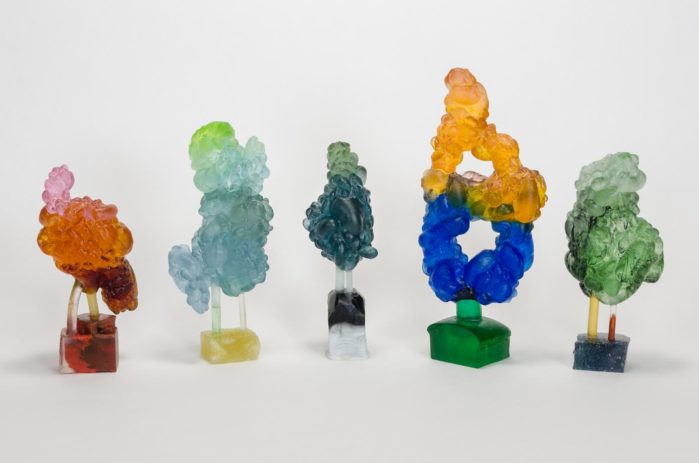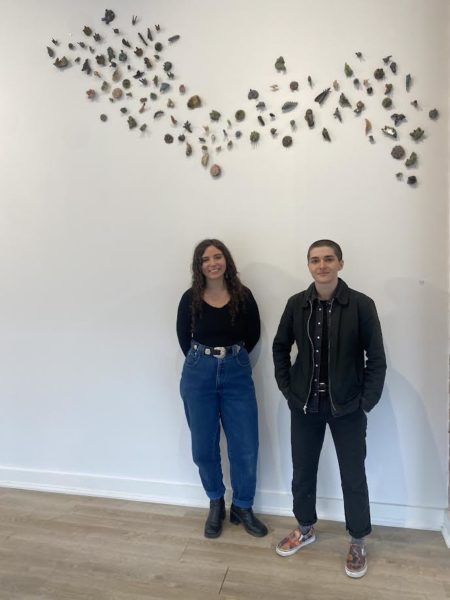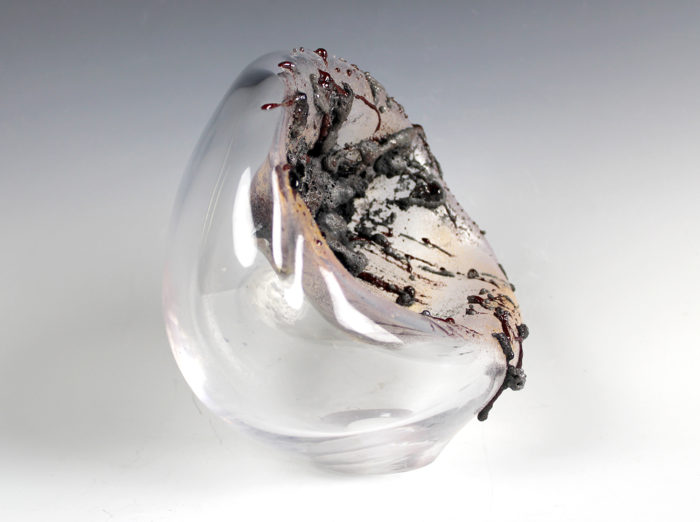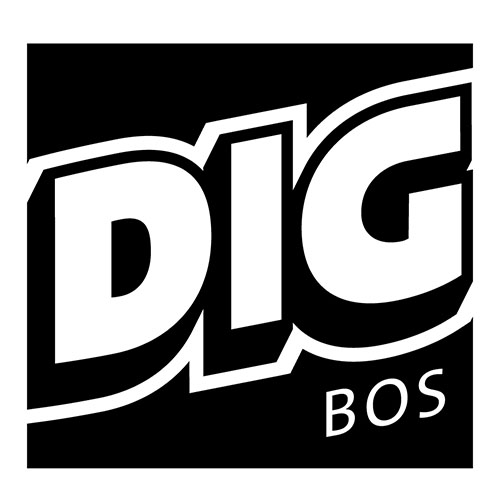The work is perfectly imperfect: textured, rough, and freaky—the opposite of what we’re told glass should look like
Glass seems static: nonadaptive, unchangeable. But it’s actually an amorphous solid—meaning its molecules are always bouncing, allowing it to be shaped and reshaped, formed and reformed.
This idea of reformation runs through glassmakers Siena Hancock and Lindsy Marshall’s exhibition DeGlassification at Brookline Arts Center, which runs through July 10. The artist duo, who became friends while studying at MassArt, question the rigidity of both the material and the culture of glasswork. They take whatever’s given and create something more interesting, seeking collaboration in every way possible.
Much of the work in DeGlassification was actually created by re-melting leftovers from other artists’ works. “We’re basically the raccoons of glass,” says Hancock, who works as a manager at a local glass studio that produces artworks for influential contemporary artists. Three years ago, Hancock found themself enamored with the odd shapes naturally formed while melting wax out of rubber molds and began collecting them to experiment with. This fascination led to VV1-5, a series of miniature sculptures of leftover bits that look like fluorescent tumors, each containing traces of other artists’ visions yet growing into their own meaning.

The sculptures are whimsical, each perched atop a lost-and-found foot or a once-fragile styrofoam block captured in pastel glass. With a tongue-in-cheek attitude, Hancock’s borrowed artworks draw attention to the invisible hands of fabricators who make some of the most well-known glass artworks of our time without the credit, a form of collaboration many overlook while seeing the final piece.
And in the spirit of collaboration, Hancock created many of their pieces in response to Lindsy Marshall’s work. Marshall, too, uses found materials in her practice.
 “To be an artist is to be a hoarder,” she says, admitting to digging through studio trash cans for pieces and collecting scraps for later use.
“To be an artist is to be a hoarder,” she says, admitting to digging through studio trash cans for pieces and collecting scraps for later use.
Marshall’s work, which represents her relationship with nature, beautifully illustrates the unpredictability of glass.
“As glass artists,” she explains, “glass is the material but it’s also the maker. I believe it has a voice of its own. It wants to do what it wants to do, but we’re forcing it to do what we want it to do. It’s symbiotic but it also is kind of like headbutting.”
Her work is perfectly imperfect: textured, rough, and freaky—the opposite of what we’re told glass should look like, but interestingly enough, that’s what glass wants to do when it’s set free instead of closely controlled. In her series, Investigation Table, Marshall plays with the material, asking questions rather than demanding a specific result, like, What happens if you use a ceramic dish as a mold? Or, What if glass didn’t look like glass? Each piece looks like some divine mix of amoeba, bark, and geode, like something that could very possibly be formed without human intervention yet required so many human decisions to make.
For both Marshall and Hancock, remixing the expectations of glass as a medium is equally as important as remixing the expectations of the culture of glassworking. Both were trained in the spirit of the Contemporary Craft movement, which demands artists choose a specialty and stick to it, making the same thing over and over again to perfect their craft. But Marshall and Hancock are doing the opposite. Neither strives for perfection, opting to play instead. Neither strives to make the clearest or shiniest piece, but the most provocative. Neither makes goblets. Instead of purely following in the steps of their (often male) predecessors, they make works about feminism, authorship, and elitism in the art world, calling passersby to ask questions rather than purely admire.

Through her Duality of Herself series, Marshall illustrates the push and pull required of an artist, walking the line between making work that’s desirable and showable in galleries and her passion to create work that’s less easily commercialized. The result is a breathtaking trio of glass orbs, perfectly clear on one side yet smeared with sticky resinous glass paste pushed into the other side. As a female emerging artist needing to make a living, there’s a sort of crushing demand to please, to sacrifice somewhat to appeal to buyers. Marshall gives them what they want—at least on one side—yet still pushes back with her signature grime.
Hancock’s work, too, investigates the commercial side of the art world. Their cycloptic white sculpture F>F is based on the type of molds they use at their studio using wax, stainless steel mesh, and a fiberglass-hydrocal paper maché. Because Hancock loved how the unfired molds looked, specifically those of this one artist known for her sci-fi style figurative sculptures, they decided to create a sculpture capturing that process. F>F is a ghostlike impression of another artist’s work, a shadow of another sculpture Hancock had a hand in creating. F>F, which doesn’t read like a glass work but is entirely about glasswork, elevates the labor and processes of artmaking instead of merely the shiny finished products sold for many thousands of dollars.
Glasswork is a medium intertwined with class and privilege. Because glassworkers need extensive training and access to costly studio equipment, well-known artists often have wealth or connections to important circles. So for Hancock and Marshall, using scraps from other artists’ work is both practical and an act of resistance. Hancock explains that artists on that level often “don’t know anything about normal people or normal life. And I think making art for normal people that they’ll be able to understand and appreciate is high art, and it should be able to be elevated.”
And not only do Hancock and Marshall create approachable work, DeGlassification is shown in an accessible space, at BAC’s satellite location in Sanctuary Medicinals, a gallery lined with huge streetlevel windows that bring unexpecting people in daily. Visit the dispensary on May 21 from 10am to 5pm to see DeGlassification and visit the popup marketplace the artists are hosting to support local glass artists.
sanctuarymed.com
Emily Bass is an independent curator and journalist whose work focuses on identity and presentation through the lenses of queerness and pop culture. Her writing has appeared in Art New England, Boston Hassle, Dig Boston, and WBUR’s The ARTery, and in 2019, she curated Face Value: Art, Makeup & Identity at Dorchester Art Project.

